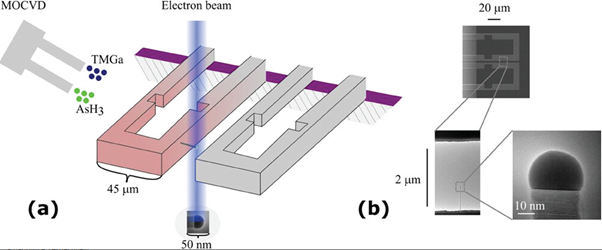
Schematic a) of two neighboring microheaters on a chip mounted in the ETEM. The illumination of a nanowire growing epitaxially from the microheater sidewall is indicated by the resulting image of the nanowire. The precursors are injected from two separate side ports into the microscope column. The resulting ex situ SEM and in situ TEM images b) illustrate the microheaters and low and high magnification of a nanowire, respectively. (CC BY 4.0, Small Methods 9, 2400728)
Microheater Controlled Crystal Phase Engineering of Nanowires Using In Situ Transmission Electron Microscopy
Crystal Phase Quantum Dots (CPQDs) offer promising properties for quantum communication. In a collaboration between Technical University of Denmark (DTU) and Lund University (LU), the crystal growth of CPQDs have been explored in detail using in situ environmental transmission electron microscopy (ETEM), together with custom-built microelectro-mechanical system (MEMS) chips with monocrystalline Si-cantilevers for temperature control. The micrometer size of the cantilevers allows temperature shifts of more than 100 °C within 0.1 s at the nanowire growth temperature, which can be much faster than the growth time for a single lattice layer. For controlling the crystal phase, the temperature change is found to be superior to precursor flow, which takes tens of seconds for the crystal phase formation to react. This μMOVPE approach may ultimately provide faster temperature control than bulk MOVPE systems and hence enable engineering sequences of CPQDs with quantum dot lengths and positions defined with atomic precision.
The work was recently published in Small Methods, Volume 9, 2025, 2400728 by Christopher R. Y. Andersen and Kristian S. Mølhave at DTU, and Marcus Tornberg, Sebastian Lehmann, Daniel Jacobsson, Kimberly A. Dick at LU (where C. R. Y. Andersen has joint affiliation).
